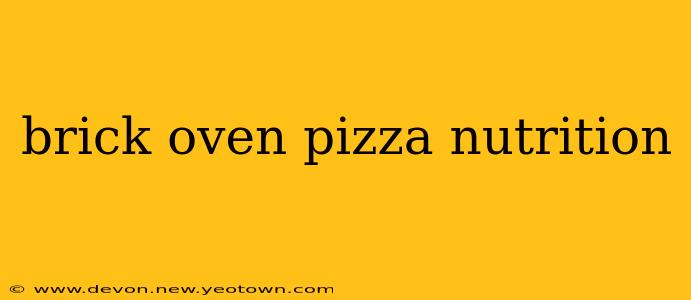The aroma of a perfectly charred pizza crust, the bubbling cheese, the vibrant colors of fresh toppings – brick oven pizza is a culinary experience that tantalizes the senses. But beyond the deliciousness, lies a question many pizza lovers ponder: what's the nutritional breakdown of this beloved dish? Let's delve into the world of brick oven pizza nutrition, uncovering the facts and addressing common concerns.
This isn't your average frozen pizza; brick oven pizza, with its high-heat cooking method, often boasts a unique texture and flavor profile. However, the nutritional content can vary wildly depending on several factors – the type of crust, the sauce, the cheese, and, of course, the toppings.
How Many Calories Are in Brick Oven Pizza?
This is perhaps the most frequently asked question. The calorie count in a brick oven pizza can range significantly. A small, thin-crust pizza with simple toppings might clock in around 400-600 calories, while a large, deep-dish pizza loaded with extra cheese and meat can easily surpass 1000 calories. It truly depends on the specific ingredients and portion size.
What are the Nutritional Benefits of Brick Oven Pizza (If Any)?
While not a health food per se, brick oven pizza can offer some nutritional benefits depending on the ingredients. A pizza made with whole wheat crust provides fiber, contributing to digestive health. Toppings like vegetables add vitamins, minerals, and antioxidants. Even the cheese offers calcium and protein. However, these benefits are easily overshadowed by less healthy elements if you're not careful with your choices.
Is Brick Oven Pizza Healthier Than Other Types of Pizza?
This is a tricky question. The cooking method itself doesn't inherently make brick oven pizza healthier. The high heat can create a crispier crust and potentially enhance the flavor of certain toppings, but the nutritional profile largely depends on the ingredients. A brick oven pizza loaded with processed meats and excessive cheese will be no healthier than a similarly loaded pizza from another oven type. The key is ingredient selection.
What are the Ingredients in Brick Oven Pizza?
The ingredients can vary widely from pizzeria to pizzeria. Typically, brick oven pizza will include:
- Dough: This is usually made from flour, water, yeast, and salt. Some pizzerias use whole wheat flour or other alternative flours for a healthier option.
- Sauce: Most commonly tomato-based, but variations exist. The sauce may contain added sugar, salt, and herbs.
- Cheese: Mozzarella is the most popular choice, but other cheeses like provolone or parmesan are also common.
- Toppings: The possibilities are endless! Common toppings include vegetables (onions, peppers, mushrooms, etc.), meats (pepperoni, sausage, ham, etc.), and other additions like olives or pineapple.
How Can I Make Brick Oven Pizza Healthier?
The beauty of brick oven pizza lies in its adaptability. You can easily make healthier choices by:
- Opting for a thin crust: This reduces the overall carbohydrate and calorie content.
- Choosing whole wheat dough: This adds fiber to your pizza.
- Loading up on vegetables: Increase the vegetable-to-meat ratio for added vitamins and minerals.
- Using lean meats: Opt for chicken or turkey instead of fatty meats like sausage.
- Moderating cheese: Too much cheese adds significant calories and saturated fat.
Ultimately, brick oven pizza nutrition is a matter of balance and mindful ingredient selection. By making smart choices about the crust, sauce, cheese, and toppings, you can enjoy this delicious treat without completely derailing your health goals. Remember, moderation is key!

